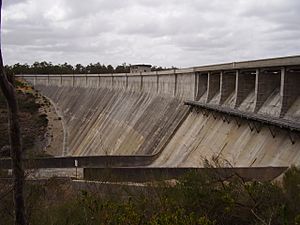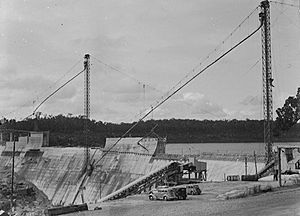Canning Dam facts for kids
Quick facts for kids Canning Dam |
|
|---|---|

The dam wall and spillway
|
|
| Location | Roleystone, Western Australia |
| Coordinates | 32°9′9″S 116°7′42″E / 32.15250°S 116.12833°E |
| Construction began | 1933 |
| Opening date | 1940 |
| Construction cost | £1.1 million (AU£, in 1940) |
| Operator(s) | Water Corporation |
| Dam and spillways | |
| Impounds | Canning River |
| Height | 66 metres (217 ft) |
| Length | 466 metres (1,529 ft) |
| Reservoir | |
| Total capacity | 90,352 megalitres (73,250 acre⋅ft) |
| Catchment area | 804 square kilometres (310 sq mi) |
| Surface area | 501 hectares (1.93 sq mi) |
The Canning Dam is a very important source of fresh water for Perth, Western Australia. It holds back the Canning River to create a large reservoir. This dam is special because of its clever design, which was very advanced when it was built.
For many years, Canning Dam was Perth's main water supply. Even today, it provides about 20 percent of the city's fresh water. The reservoir can hold a huge amount of water, about 90.352 billion litres!
Building the dam has caused some environmental changes, like more algal blooms and changes to animal homes. But the dam and nearby areas also offer fun activities like bushwalking and picnics.
Contents
History of Canning Dam
People first thought about using the Canning River for Perth's water way back in 1896. Engineers looked at the current dam site in 1897. But even though Perth often needed more water, the government didn't start building the dam until the 1930s. This was during the Great Depression, when many people needed jobs.
Work on the Canning Dam began in 1933 and finished in 1940. It cost about £1.1 million at the time. A clever engineer named Russell Dumas designed the dam and led its construction.
In 1951, a special channel was built to bring more water from Kangaroo Gully into the dam. Canning Dam was Perth's main water source until the city grew a lot in the 1960s. Then, the Serpentine Dam was finished in 1961, providing more water.
In 1975, the Canning Dam was connected to Perth's main water system through the Canning Tunnel. This helped water flow more easily across the city. Today, Canning Dam still supplies a big part of Perth's drinking water. It also stores water from the Kwinana Desalination Plant, which turns sea water into fresh water.
How the Dam Works (Hydrology)
The Canning Dam is built in the Darling Scarp, an area mostly made of granite rock. The dam wall sits in a narrow gorge. Behind the wall, the water forms a large lake with three long arms.
The area that collects water for the dam (called the catchment) is about 804 square kilometres. The highest point in this area is Mount Cooke, which is 582 metres above sea level.
The area usually gets about 900 millimetres of rain each year, mostly between May and September. However, the amount of rain can change a lot across the catchment. Since 1975, the amount of rainfall and water flowing into the dam has decreased. This means the dam gets less water than it used to.
Building the Dam
Building the Canning Dam solved Perth's long-standing water problems. Before the dam, Perth's water was often not clean enough or there wasn't enough of it. This project was the biggest public work of its time. It created jobs for about 500 men, which was very important during the Great Depression.
The dam used new and clever building methods that were new to Australia. For example, engineers had to make sure water didn't leak between the dam's foundation and the concrete. They dug a special trench and added drains inside the dam to catch any leaks. This internal drainage system was very advanced for the time.
Workers used a mix of modern machines and hand labour. Skilled workers built the molds for the concrete. For the first time in Australia, cement was handled in bulk, saving a lot of money compared to using bags.
Building the dam went smoothly for the most part. However, in March 1934, a huge storm brought 130 millimetres of rain in less than two days. This caused the river to flood the dam's construction site. But pumps were installed, and work started again just three days later.
The dam was finished in September 1940. When it was built, it was the longest concrete dam in Australia. It was also the second highest. Even today, it is still one of the largest concrete dams in Western Australia. The dam was finished on time and cost less than expected!
Fixing the Dam
Recently, some cracks appeared in the upper parts of the Canning Dam. Experts found that these cracks were caused by a chemical reaction in the concrete called AAR (alkali aggregate reactivity). This reaction makes the concrete swell and can cause cracks. Many old concrete dams around the world have this problem.
Between 1999 and 2001, major repairs were done to make the dam wall stronger. Workers removed the top 3.8 metres of the wall. They then drilled deep holes through the dam and into the rock below. The top part of the wall was rebuilt with stronger concrete. Finally, giant "ground anchors" were put into the holes. These anchors are like huge bolts that hold the dam firmly to the bedrock. They were the biggest and longest anchors ever used in the world at that time!
A special drilling method called Penetrating Cone Fracture (PCF) was used for the repairs. This method was chosen because it caused less damage to the dam from vibrations and created less dust.
Environmental Changes
Since the Canning Dam and other dams were built, the amount of water flowing into the Canning River has dropped by a lot (up to 96%). This has caused problems for fish that live in the river. There are fewer fish because they have lost their homes. Also, low water levels make it hard for fish to move upstream to their breeding areas. Still water has also helped an unwanted fish, the mosquitofish, to breed more easily.
The lack of water flow has also led to more algal blooms in the river. This happens when too many nutrients from fertilisers and animal waste build up in the water.
Many river pools, which are important places for plants and animals in summer, have disappeared. This is because of dirt building up (sedimentation) and changes in how the river flows due to the dam.
The Canning River needs regular floods from the dam to help seeds grow and to keep the river healthy. Floods also help fill up underground water supplies and stop weeds from growing. But when there isn't much rain, these important floods happen less often.
Fun Activities at the Dam
The Canning Dam and the areas around it offer many fun things to do. There are picnic spots with gas barbecues, lookouts with great views, and historic walks. Some of these areas are even easy to access for people with disabilities.
You can go bushwalking on trails like the Bibbulmun Track, which passes near the dam. There are also several mountain bike trails in the nearby parks and forests.
It is against the rules to fish for marron (a type of crayfish) in the Canning Reservoir, Canning River, and its smaller streams. For health and safety reasons, you are not allowed to go boating, fishing, or swimming in the reservoir. Camping outside of special areas is also not allowed.
Engineering History
The Canning Dam has been recognised as an important engineering achievement. It received a special marker from Engineers Australia for its historical importance in engineering.
Gallery








